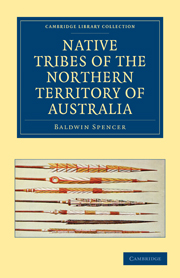Book contents
- Frontmatter
- Preface
- NOTE
- Contents
- LIST OF ILLUSTRATIONS
- CHAPTER I INTRODUCTION
- CHAPTER II SOCIAL ORGANISATION AND MARRIAGE REGULATIONS
- CHAPTER III INITIATION CEREMONIES
- CHAPTER IV TOTEMIC SYSTEMS AND TOTEM GROUPS
- CHAPTER V SACRED STICKS, BULL-ROARERS, AND CEREMONIAL OBJECTS
- CHAPTER VI BURIAL AND MOURNING CEREMONIES
- CHAPTER VII MAGIC AND MEDICINE
- CHAPTER VIII BELIEFS IN REGARD TO THE ORIGIN OF CHILDREN
- CHAPTER IX TRADITIONS CONCERNING IMBEROMBERA, THE GREAT ANCESTOR, AND ALSO OTHER ANCESTORS OF THE KAKADU NATION
- CHAPTER X VARIOUS TRADITIONS, CUSTOMS, AND BELIEFS
- CHAPTER XI FOOD RESTRICTIONS
- CHAPTER XII WEAPONS AND IMPLEMENTS
- CHAPTER XIII CLOTHING AND ORNAMENT
- CHAPTER XIV DECORATIVE ART
- APPENDIX
- GLOSSARY OF NATIVE TERMS
- INDEX
- Plate section
- Plate section
CHAPTER VII - MAGIC AND MEDICINE
Published online by Cambridge University Press: 05 July 2011
- Frontmatter
- Preface
- NOTE
- Contents
- LIST OF ILLUSTRATIONS
- CHAPTER I INTRODUCTION
- CHAPTER II SOCIAL ORGANISATION AND MARRIAGE REGULATIONS
- CHAPTER III INITIATION CEREMONIES
- CHAPTER IV TOTEMIC SYSTEMS AND TOTEM GROUPS
- CHAPTER V SACRED STICKS, BULL-ROARERS, AND CEREMONIAL OBJECTS
- CHAPTER VI BURIAL AND MOURNING CEREMONIES
- CHAPTER VII MAGIC AND MEDICINE
- CHAPTER VIII BELIEFS IN REGARD TO THE ORIGIN OF CHILDREN
- CHAPTER IX TRADITIONS CONCERNING IMBEROMBERA, THE GREAT ANCESTOR, AND ALSO OTHER ANCESTORS OF THE KAKADU NATION
- CHAPTER X VARIOUS TRADITIONS, CUSTOMS, AND BELIEFS
- CHAPTER XI FOOD RESTRICTIONS
- CHAPTER XII WEAPONS AND IMPLEMENTS
- CHAPTER XIII CLOTHING AND ORNAMENT
- CHAPTER XIV DECORATIVE ART
- APPENDIX
- GLOSSARY OF NATIVE TERMS
- INDEX
- Plate section
- Plate section
Summary
In the Kakadu tribe there is a very curious form of magic, the ceremony connected with which is called Tjilaiyu. It is concerned with injuring a person by means of dealing in a very special way with some of his excrement or korno. Because of this, everyone is most careful to cover over and hide from view all excrementa, one result of which is that Kakadu camps are more cleanly than those of many other tribes. It is not, however, a difficult matter for a man who wishes to injure an enemy to secure some korno. A medicine man, for example, will find out where it is buried and then, when no one is watching, he will go to the place and rake a little into a piece of bark with a stick, because it must not be touched. There are always at least three men who take part in the ceremony. The man who has secured the korno hands it, in the bark, to one of the others, who ties it round with string. It is then taken away from the camp out into the bush to a quiet spot where no one is likely to come. The performers have previously provided themselves with a supply of wax, both beeswax and a kind of resin, called kapei, derived from the root of the iron-wood tree. They make five little spherical balls, one of kapei and four of beeswax.
- Type
- Chapter
- Information
- Native Tribes of the Northern Territory of Australia , pp. 257 - 262Publisher: Cambridge University PressPrint publication year: 2010First published in: 1914

